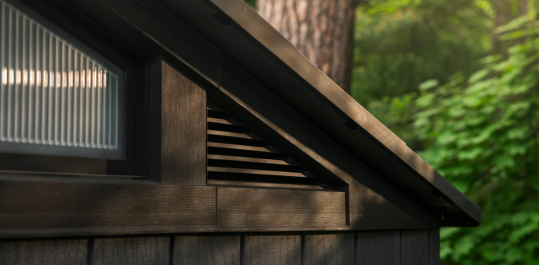
How Can You Keep Moisture Out of Your Shed?
You open the shed to grab a tool, and bam! There it is. That musty smell. Maybe the floor feels a little soft, the walls look warped, or your tools have started to rust.
Moisture isn’t just a small problem; it can ruin everything you’re trying to store and slowly eat away at the shed itself. This happens with certain shed material types like wood or metal, but it will not be an issue with Keter resin sheds. Keter outdoor sheds have built-in shed ventilation, which means this isn’t an issue. However, if you have another type of shed, it’s essential to understand what needs to be done about moisture.
This guide breaks it all down: how water gets in, what it can do and what you can do about it. From smart construction tips to easy DIY fixes, we’ll walk you through how to keep a shed dry inside, protect your storage and stop the damage before it starts.
What Causes Moisture in a Shed?
If you’re trying to figure out how to keep moisture out of a shed, it helps to understand where that moisture is coming from in the first place. Most of the time, it’s not just one thing. It’s a mix of sneaky little problems adding up.
- Condensation is a big one. When warm air inside your shed hits cold surfaces (like the walls or roof), it turns into water. That’s what causes the inside to feel damp, even if it hasn’t rained in days.
- Then there’s ground moisture, which is especially common if you have a wooden shed, sits directly on soil or a slab without a vapor barrier. Water can slowly rise from the ground and soak into the floor of wooden sheds over time.
- Leaks are another culprit. Tiny gaps around windows, doors or roof seams can let water drip in during a storm. And if your yard has poor drainage, rainwater can pool around the base of your shed, seeping in at ground level.
- Finally, don’t overlook the plants. Overgrown shrubs or trees pressed up against your shed can trap moisture against the walls and keep things from drying out properly.
Knowing where moisture comes from is the first step in stopping it. Once you spot the problem, you can take the right steps to keep your shed dry inside.
Building Right: Best Practices for a New, Dry Shed

If you’re still in the planning stage, or thinking about replacing an older outdoor storage building, this is the best time to get ahead of moisture problems. A smart setup makes all the difference when it comes to how to keep moisture out of a storage shed long-term.
It matters where you put the shed. You'll want to avoid low-lying areas that collect water after it rains, and keep some distance from trees and overgrown bushes. They might offer shade, but they’ll also trap moisture.
Next, think about your shed base. Concrete is solid and long-lasting, but it must be paired with proper drainage. Wood is easier to work with and keeps the shed off the ground, but it’ll need to be treated to resist rot. Gravel is a really great option since it’s DIY friendly and it provides great drainage. Plastic grid bases are low-maintenance and provide great drainage, but might not hold up as well for heavier sheds.
Lastly, consider getting a shed with built-in ventilation. Keter’s resin sheds, for example, offer built-in ventilation and come in easy-to-assemble kits. So, you can set up a base, the shed, and it’ll ventilate.
Getting these basics right up front saves you time, money and hassle down the road, and it’s the easiest way to keep your new storage shed dry from the ground up.
The Dry Shed Checklist: 10 Ways to Fix a Damp Shed
Already have a shed that’s letting in moisture? Don’t worry, you don’t have to start over. There are a lot of fixes that are simple and can make a big difference. Here’s how to keep water out of your shed and protect what’s inside:

- Seal it up: Check for gaps around doors, windows and where the walls meet the roof. A little caulk goes a long way.
- Add ventilation: Stale, humid air needs a way out. Wall vents, gable vents or a shed with built-in ventilation can make a huge difference.
- Insulate the interior: Insulation helps regulate temperature, which cuts down on that warm-air-meets-cold-surface moisture problem.
- Install gutters and downspouts: They’ll move rainwater away from the base of your shed instead of letting it pool at the edges.
- Use a dehumidifier: Especially helpful if you’re storing tools, electronics or anything sensitive to damp air.
- Try moisture absorbers: Silica gel is an easy, low-cost way to manage humidity in tight spaces. It is important to note that while it’s non-toxic, it can be a choking hazard and can cause other issues. So, make sure to keep children and pets away from it, and do your research before using it.
- Seal the floor of your Wood or Metal Shed: While this is not needed for Keter resin sheds, a waterproof paint or sealant for your wood or metal shed adds another barrier between ground moisture and your stuff.
- Trim back plants: Trees and shrubs hold moisture close to the shed walls and slow down drying after rain.
- Store smart: Keep items up off the floor and even consider using shed shelves and away from walls. Airflow helps more than you’d think.
- . Keep up with maintenance: A quick seasonal check for leaks, clogged gutters or worn-out seals can prevent small problems from becoming expensive ones.
You don’t need to do all ten things at once, but each step gets you closer to a shed that stays dry, clean and useful all year long.
FAQs: Your Moisture Questions, Answered
Moisture
Waterproof
Mold
Ready to skip the hassle of constant upkeep? Like we touched on above, Keter garden sheds are built tough with durable resin that won’t crack, rust, rot or peel, and they come with built-in ventilation to help keep moisture at bay. So, if you want a low-maintenance, long-lasting shed that keeps items ventilated and protects your things, a Keter shed is definitely worth checking out.

We build in a sustainable manner.
We use innovative materials and leading technologies to build planet-friendly products that last a lifetime.
















